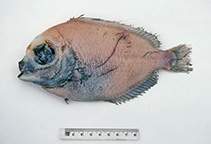| Family: |
Caristiidae (Manefishes) |
| Max. size: |
19.3 cm SL (male/unsexed); 21.9 cm SL (female) |
| Environment: |
bathypelagic; marine; depth range 420 - 1360 m |
| Distribution: |
Southern Hemisphere: from the southern Indian Ocean (off the coast of Africa); South Pacific (off the coasts of Tasmania and New Zealand); South Atlantic. |
| Diagnosis: |
Dorsal soft rays (total): 28-31; Anal soft rays: 18-21; Vertebrae: 32-35. This species is distinguished by the following characters: with vomerine but no palatine teeth; posteriorly placed dorsal-fin origin, with predorsal distance >87% HL; vertically oriented anteriormost dorsal-fin pterygiophores; distinguished from Paracaristius by its short pharyngobranchial teeth (vs. long and needle-like in Paracaristius), presence of a lateral line, orbit size (>42%SL vs. <45%SL in Paracaristius); distinguished from all other caristiid genera by the broad suborbital space, with an expanded suborbital shield of bony elements, and by the small mouth, with upper jaw covered laterally by suborbitals and not extending to posterior margin of orbit (Ref. 87954). |
| Biology: |
Area of collection attributed to notal and adjacent subantarctic waters (Ref. 57777). |
| IUCN Red List Status: |
Not Evaluated (N.E.) Ref. (130435)
|
| Threat to humans: |
harmless |
Source and more info: www.fishbase.org. For personal, classroom, and other internal use only. Not for publication.
